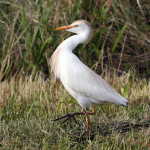• • •
Cattle Egrets get their name from their habit of wandering among herds of livestock looking for insects. They’re a common sight in fields and along roadsides as well, particularly where freshly mowed grass has stirred up a prospective meal.
• Length: 20 inches
• Wingspan: 36 inches
• Season: Year-round
More about Cattle Egrets.
Where they are, and when.
Cattle Egret resemble other white herons, but are easily distinguishable. The Great Egret is much larger with a long neck and bill; the Snowy Egret has unique yellow feet and a dark bill; and the juvenile Little Blue Heron has a pale bill and legs.
Cattle Egret have yellowish legs and a short yellow bill, except in breeding season, when their legs and bill turn red and pale orange plumes adorn their head, breast and back.
Unlike other herons that frequent marshes and ponds, they forage more in dry fields and grasslands for their diet of grasshoppers, crickets, spiders, flies, frogs and worms.
Originally from Africa, Cattle Egret migrated first to South America before arriving here in the early 1950s, where they have obviously thrived. They breed in colonies with other herons in isolated forest, islands and swamps.
April 10, 2008
A solitary Cattle Egret was walking in the grass alongside the canal at Anahuac National Wildlife Refuge. Its gait recalled Monty Python’s skit, the Ministry of Silly Walks. It moved its head forward, then coiled it back, raised its left leg, paused and then stepped forward in an exaggerated way. It was in full mating colors but there wasn’t another Cattle Egret in sight, so I’m not certain what was going on. It was still making its way deliberately down the canal when I drove off toward Shoveler’s Pond.
• • •
May 14, 2013
The fields on the roadside on the way to San Bernard National Wildlife Refuge were peppered with Cattle Egret, probably more than a hundred making their way through the grass. The explanation lay just a bit further ahead, where tractors were doing their spring mowing. No doubt they had stirred up grasshoppers and other insects that drew the white swarm. Word travels fast.






You must be logged in to post a comment.